Aiyanar
| Aiyanar | |
|---|---|
| Guardian, Preservation | |
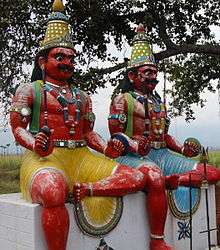 Folk sculpture of Ayyanar at Gopichettipalayam. | |
| Tamil language | ஐயன், சாஸ்தா |
| Affiliation | Hariharaputra, Ayyappan |
| Abode | Shasta Bhuvanam |
| Weapon | whip or scepter |
| Mount | Elephant, horse, tiger |
| Consort | Puranai, Pushkalai |
Aiyanar or Shasta (IAST: Aiyaṉār, Śāstā, Tamil: ஐயனார், சாஸ்தா) is a Hindu deity particularly praised by the Malayalis and Tamil speaking community of India and Sri Lanka.[1][2][3] Sinhalese worship him in the name of Ayyanayake and in Kerala the name is Ayyappan. Some studies suggest that Ayyanar could be worshipped even in South east Asian countries in the past.[4] He is primarily worshiped as one of the guardian folk deities of Tamil Nadu.[5] The village temples of Ayyanar are usually flanked by gigantic and colorful statues of him and his companions riding horses or elephants.[6] The well known shrine at Sabarimala is actually a Sastha temple though its main deity Ayyappan is now developed distinct from Ayyanar.[7]
Etymology

The Tamil word Ayyanār is derived from the root word Ayyan, a honorific used in all Dravidian languages to designate either respectable or elder people.[8][9] Some people propose that Aiyan could be the Tamilized version of Sanskrit root Arya which means the same.[10] There is a well known temple dedicated to Shasta situated in a village of Kerala, called "Aryankavu". Since Tamil Ayya sounds like the Pali equivalent of Ayya (Arya), the vice versa argument is prevalent.[11] Another name of Ayyanar, Sastha,[12] meets the same dispute. Although he appears as Shasta in Sanskrit scriptures, ancient Tamil records mention him as Chattan (சாத்தன்,Cāttaṉ).[13] Though Śāstā is the term especially used to indicate Ayyanar nowadays, there are two other deities known in the same name. Buddha is also called Shasta and Brahma-Śāstā is the another name of Murugan. Shasta is a generic Sanskrit term for a teacher.
Development
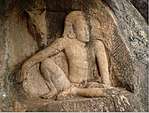
There are very few evidences available to construct the origin and development of Ayyanar. Since Sastha is the synonym of Buddha, some researchers assume Chattan could be immigrated to Tamil country with Buddhism.[14] Some others oppose that Ayyanar still remains with his archaic dravidian nature and he is obviously a South Indian deity who might be absorbed into Hindu pantheon later in the name of Shasta.[3][15] The earliest references to Ayyanar were discovered in the hero stones of hunting chieftains from Arcot, Tamil Nadu dated back to the 3rd century C.E. The phrase in the inscriptions which could be translated into "Ayyanappan; a shrine to Cattan" confirms that Ayyan and Chattan were the names of a single deity.[12] A rock carving of the man and the horse in the Isurumuniya Buddhist temple of Sri Lanka, is identified with Ayyanar.[16] Sinhala buddhists of Sri Lanka praise him in the form of a folk deity called Ayyanayake to the date.[17]
According to Fred Clothey, Aiyanar is a Tamil adaptation of Aiyan, the chief deity of Ay chieftains who ruled parts of Kerala and Tamil Nadu, the then Tamilakam. He also states that the term aayar meaning a cow herder and a protector is an appropriate appellation for both the Ay chieftains and their clan deity.[10] Tamil Sangam literature often mention poets and traders with the name Chattan, who might revere Sastha as their clan deity.[18] Tamil epic Silappatikaram, probably dated back to 4th century CE, records the temples and devotees of Cattan.[12] The 7th century CE Saivite Nayanar and one of the initiator of Tamil Bhakti movement, Appar praises Shiva as the father of Chattan in his Tevaram (Tirumurai - 4:32:4).[19] Sastha started to appear in northern sources from 7th century CE after Brahmanda Purana. It narrates the history of Hariharasuta, son of Hari and Hara, who was born to Shiva during his copulation with Mohini, the feminised form of Vishnu, after the churning of milk sea.[12] Periya Puranam, a Tamil Saivite epic of 12th century CE tells that Aiyanar at Tiruppidavur exposed the Tamil song of Cheraman Perumal, a nayanar - cum - Chera king (800—844 CE) which was revealed by him in Kailash. From the Chola period (9th century) onwards the popularity of Aiyanar became even more pronounced and so many bronze images of him are available in this period.[12]
Kanda puranam, 14th century Tamil version of Skanda Purana narrates the history of ayyanar in Maha chattan patalam which seconds the story told in Brahmanda purana. Here Ayyan, Kanda puranam tells, send his chief commander Mahakala to protect Indrani from the demon Surapadman. Mahakala chops down the hands of Ajamukhi, sister of Surapadman who tried to abduct Indrani for her brother.[20][21] Sabarimala Sthala Puranam, a recent purana explains Ayyappan is the avatar of Ayyanar.[22] Other records on Ayyanar tells that he has two wives popularly known as Purana and Pushkala.[12] Shilparatna explains him with only one wife called Prabha and their eight years old lad known as Satyakan[21] though his appearance with two wives is the widespread iconography in his South Indian temples. Kanda puranam and cholan bronzes describe his mount of white elephant. Horse is another mount abundantly seen in his local temples. Some folk beliefs explain that Ayyanar is awaiting to ride his horse to immediately help his devotees. After the popularity of Ayyappan cult, tiger is also identified as the mount of Sastha.[21]
Connections with Ayyappan
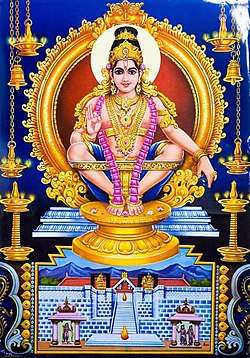
Sabarimala is a temple in kerala dedicated to Ayyappan becomes famous recent times. The number of pilgrims going to Sabarimala increases year to year though Ayyappa is unknown in Tamil region before 1940s.[23] A deity named "Ayyappan" is not recorded in any early sources in Tamil and Sanskrit. There are so many evidences to prove that Ayyappan is recent variant and he is none other than Ayyanar.[7][24] Even the name Ayyappan reveals that it is the sync. form of Ayyan (Ayyanar) + Appan (father).[25][26] Yogapatta bar around the knees of Ayyappan is the distinct character that can be seen in the Ayyanar statues of Chola period. The horse mount of Aiyanar is still visible in the flag staff of Sabarimala Ayyappan temple.[27] No anyone denies the synonym Sastha of Ayyappan, which is obviously the synonym of Ayyanar.[28][29] Another important association is the presence of Karuppa samy in the worship of both deities. Tamil devotees did not descriminate Ayyappan with Ayyanar and they believe that Ayyappan is the avatar of Ayyanar.[3] It can be noted that Sri Lankan Ayyanar temples are being converted into Ayyappan temples following the outbreak of Sabarimala pilgrimage of Sri Lankan devotees in recent years.[30]
Worship
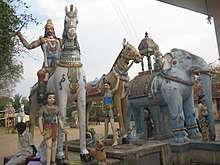
The main iconographic aspects of Ayyanar include whip or scepter in his hand and a meditation band around his knees in a squat, known as Yogapaţţam or Vāgupaţţai.[31] Weapons such as sword, trishula or a Vel are also associated with this deity. He can be seen seated alone or with two wives in either sides.His mount elephant or horse will be standing in front of him. In rural areas, Aiyanar is often represented with an escort, usually composed of the god's vassals, sometimes comprising demons. Consistent with this practice, terracotta horses are usually placed outside the temple. These are given up to the god as steeds for his night time perambulations.
So many temples are dedicated to Ayyanar can be seen all over the South India as well as Sri Lanka. Almost all villages of Tamil Nadu would have an Aiyanar kovil.Ayyanar shrines are usually located at the peripheries or boundaries of rural villages and the deity is seen riding a horse with a sword or whip. Ayyanar has both types of temples - Temples constructed in Agamic style and non-agamic open air shrines. Ayyanar in Agamic temple is usually called Sastha or Dharma sastha.[16][32] Kerala retains its Ayyanar temples as Sastha temples.[33] The attendant priest for the Aiyanar is generally from the potter caste who fashions idols and clay horses, although it is not uncommon for priests from other castes to officiate in the Ayyanar temples.[31][34][35] Many castes of Tamil Nadu worship Ayyanar as their Kula deivam.
Image Gallery
 Bronze statue of Ayyanar on Elephant, 16th century CE, Tamil Nadu
Bronze statue of Ayyanar on Elephant, 16th century CE, Tamil Nadu Ayyanar sculptures at Gopichettipalayam
Ayyanar sculptures at Gopichettipalayam Ayyanar on horse, Madurai
Ayyanar on horse, Madurai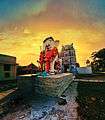 White elephant mount at Agamic Ayyanar temple, Mampatti
White elephant mount at Agamic Ayyanar temple, Mampatti- Kattuvalli Ayyan Kovil, Kerala
 Horses of Ayyanar
Horses of Ayyanar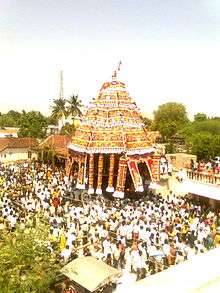 Ayyannar Car festival, Thungapuram
Ayyannar Car festival, Thungapuram
See also
| Wikimedia Commons has media related to Aiyanar. |
Notes
- ↑ Narayanan, Gita; Thiagarajan, Deborah (2001). DakshinaChitra: A Glimpse of South India. Madras Craft Foundation,. pp. 40–41.
- ↑ Kulendiren, Pon (2012). Hinduism a Scientific Religion: & Some Temples in Sri Lanka. iUniverse. p. 188. ISBN 9781475936735.
- 1 2 3 Mãrg, Volume 37, Issues 3-4. Marg Publications. p. 67.
- ↑ Pal, Pratapaditya (1986). "American Collectors of Asian Art". Marg publications. 37: 67.
- ↑ Christa Neuenhofer (2012). Ayyanar and Mariamman, Folk Deities in South India. Blurb Incorporated. ISBN 9781457990106.
- ↑ Mark Jarzombek. "Horse Shrines in Tamil India: Reflections on Modernity" (PDF). Future Anterior. 4 (1): 18–36. doi:10.1353/fta.0.0031
- 1 2 Dalal, Roshen (2010). Hinduism: An Alphabetical Guide. Penguin Books India. p. 54. ISBN 9780143414216.
- ↑ Indian Antiquary, Volume 2. Popular Prakashan. 1873. p. 168.
- ↑ Indrapala, K., The evolution of an ethnic identity: The Tamils in Sri Lanka C. 300 BCE to C. 1200 CE, p.#
- 1 2 Smith, B. L., Religion and Legitimacy of power in South Asia, p.6
- ↑ Pathmanathan, S (2000). Reflections on a Heritage: Historical Scholarship on Premodern Sri Lanka. Sri Lanka: Central Cultural Fund, Ministry of Cultural and Religious Affairs. p. 88. ISBN 9789556131086.
- 1 2 3 4 5 6 Williams, Joanna Gottfried; Hunnington, Susan L. (1981). Kalādarśana: American Studies in the Art of India Volume 9 of Studies in South Asian Culture. Brill. p. 67. ISBN 9789004064980.
- ↑ Cutantiran̲, Ā Vēluccāmi (2001). Temples of Nannilam Taluk: as iconographical masterpieces Volume 225 of Tamil̲p Palkalaik Kal̲aka veḷiyīṭu. Thanjavur Tamil University. p. 205.
- ↑ Sadasivan, S. N. (2000). A Social History of India. APH. p. 121. ISBN 9788176481700.
- ↑ Annals of Oriental Research, Volume 24. University of Madras. 1972. p. 380.
- 1 2 Pestman, P. W. (1971). Acta Orientalia Neerlandica: Proceedings of the Congress of the Dutch Oriental Society Held in Leiden on the Occasion of Its 50th Anniversary, 8th-9th May 1970. Brill Archive. p. 116.
- ↑ Velu Pillai, A. (1980). Epigraphical Evidences for Tamil Studies. Ulakat Tamil̲ārāycci Nir̲uvan̲am. p. 113.
- ↑ Venkataramaiah, K. M. (1996). A handbook of Tamil Nadu. International School of Dravidian Linguistics. p. 317. ISBN 9788185692203.
- ↑ Subramanya Aiyar, V.M. "Songs with description of twelve holy composition". Thevaaram.org. Retrieved 2 December 2017.
- ↑ Sivaraman, Dr.Akila (2006). sri kandha puranam (english). GIRI Trading Agency Private. p. 175. ISBN 9788179503973.
- 1 2 3 Tattvāloka, Volume 16. Sri Abhinava Vidyatheertha Educational Trus. 1993. p. 246.
- ↑ Devdutt Pattanaik (2000). The Goddess in India: The Five Faces of the Eternal Feminine. Simon and Schuster. ISBN 9781594775376.
- ↑ Kajaerholm (1984), p.3
- ↑ Kent, Eliza F. (2013). Sacred Groves and Local Gods: Religion and Environmentalism in South India. OUP USA. pp. 79–119. ISBN 9780199895465.
- ↑ Mikhail Sergeevich Andronov (1996). A Grammar of the Malayalam Language in Historical Treatment. Otto Harrassowitz Verlag. p. 49. ISBN 978-3-447-03811-9.
- ↑ Johannes Bronkhorst; Madhav Deshpande (1999). Aryan and non-Aryan in South Asia: evidence, interpretation, and ideology; proceedings of the International Seminar on Aryan and Non-Aryan in South Asia. Harvard University, Dept. of Sanskrit and Indian Studies. pp. 177–178. ISBN 978-1-888789-04-1.
- ↑ "Animal carriers of Lord Shree Dharma Sastha". media4news. Retrieved 3 December 2017.
- ↑ Miller, Roland E. (1976). Mappila Muslims of Kerala: A Study in Islamic Trends. Orient Longman. p. 22.
- ↑ Dubey, D. P. (2000). Pilgrimage Studies: The Power of Sacred Places Issue 5 of Pilgrimage studies. Society of Pilgrimage Studies. p. 63. ISBN 9788190052030.
- ↑ Shutharsan, S. "Arikaraputtira aiyaṉār (Tamil)". Ourjaffna.com. Analaikkumaran. Retrieved 3 December 2017.
- 1 2 'A Folk Deity of Tamil Nad' by L. Dumont, in Religion in India ed. T.N. Madan
- ↑ Sivkishen (2015). Kingdom of Shiva. Diamond Pocket Books Pvt Ltd. ISBN 9788128830280.
- ↑ Menon, A. Sreedhara (1978). Cultural Heritage of Kerala: An Introduction. East-West Publications. pp. 17–28.
- ↑ Mudumby Narasimhachary (Ed) (1976). Āgamaprāmāṇya of Yāmunācārya, Issue 160 of Gaekwad's Oriental Series. Oriental Institute, Maharaja Sayajirao University of Baroda.
- ↑ Mark Jarzombek. "Horse Shrines in Tamil India: Reflections on Modernity" (PDF). Future Anterior. 4 (1): 18–36. doi:10.1353/fta.0.0031.
References
- Kajaerholm, Lars (1984). "Aiyanar and Aiyappan in Tamil Nadu: Change and Continuity in South Indian Hinduism" (PDF). Folk. Dansk Ethnografisk Tidsskrift Kobenhavn. 26: 67–92. Archived from the original on 2016-03-04.
- Valk, Ulo (2007). "Village deities in Tamil Nadu:Myth and legends". Asian Folklore Studies. 66: 179–199.
- Smith, B. L. (1978). Religion and the Legitimation of Power in South Asia. Brill Academic Publishers. ISBN 90-04-05674-2.
- Mark Jarzombek, "Horse Shrines in Tamil India: Reflections on Modernity", Future Anterior, (4/1), pp 18–36.
- Bayly, Susan (2004). Saints, Goddesses and Kings: Muslims and Christians in South Indian Society, 1700-1900. Cambridge University Press. ISBN 0-521-89103-5.
- Clothey, Fred (1978). Many Faces of Murakan: The History and Meaning of a South Indian God. Walter De Gruyter Inc. ISBN 90-279-7632-5.
- Karthigesu, Sivathamby (1995). Sri Lankan Tamil society and politics (PDF). New Century Book House. ISBN 81-234-0395-X.
- Morris, Brian (2005). Religion and Anthropology: A Critical Introduction. Cambridge University Press. ISBN 0-521-85241-2.
- Bastin, Rohan (2002). The Domain of Constant Excess: Plural Worship at the Munnesvaram Temples in Sri Lanka. Berghahn Books. ISBN 1-57181-252-0.
- Williams, Joanna (1981). Kaladarsana: American studies in the art of India. E.J. Brill. ISBN 90-04-06498-2.
- Roberts, Michael (2008). "Tamil Tigers: Sacrificial symbolism and `dead body politics'". Anthropology Today. 24: 22–23. doi:10.1111/j.1467-8322.2008.00587.x.
- Indrapala, K. (2007). The evolution of an ethnic identity: The Tamils in Sri Lanka C. 300 BCE to C. 1200 CE. Vijitha Yapa. p. 374. ISBN 978-955-1266-72-1.
